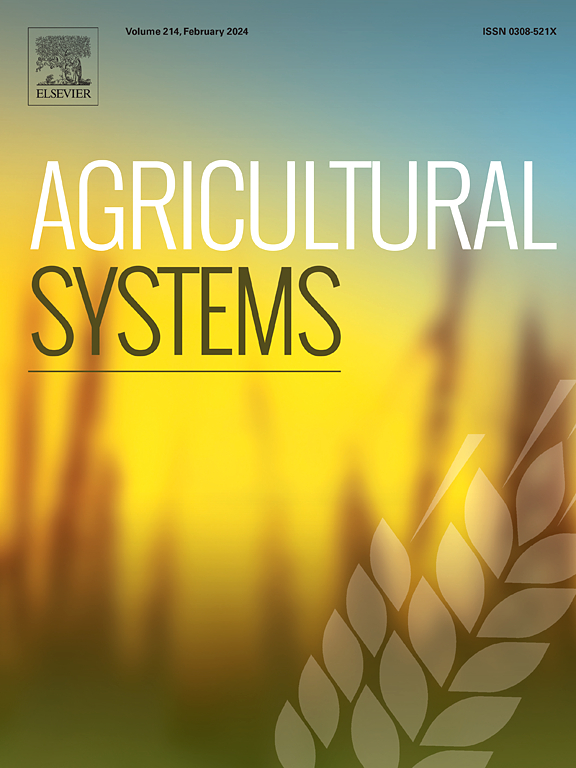Understanding the drivers of smallholder dairy cooperative participation in developing countries: Evidence from rural Zambia
IF 6.1
1区 农林科学
Q1 AGRICULTURE, MULTIDISCIPLINARY
引用次数: 0
Abstract
CONTEXT
Smallholder dairy farmers are among the primary dairy producers in developing countries. In Zambia, they contribute more than 80 % of the country's milk production, which amounts to approximately $80 million annually. Understanding the factors that influence smallholder dairy farmers' decisions to join cooperatives is crucial for enhancing cooperative participation and improving dairy production efficiency in the region.
OBJECTIVE
The primary goal of this study is to investigate the determinants of smallholder dairy farmers' decisions to join cooperatives, while also comparing the predictive performance of the random effects logit model and the random forest model in identifying these factors.
METHODS
Data were collected from 515 rural smallholder dairy farmers in Zambia. The analysis utilizes a random effects logit model and a random forest model to identify the factors influencing farmers' decisions to join dairy cooperatives.
RESULTS AND CONCLUSIONS
Three primary findings were observed. First, the RF model exhibited superior predictive accuracy compared to the random effects logit model, aligning with existing literature on the enhanced predictive capabilities of machine learning techniques. Second, several key factors, including physical proximity to cooperative offices, educational attainment, and dairy farming experience, were identified from the random effects logit model as significantly influencing current farmers' decisions to join dairy cooperatives. Third, the random forest model indicated that demographic and economic characteristics—specifically age of the household head, household size, total cow ownership, dependency ratio, and farming experience—are expected to be the most influential predictors of cooperative membership in future scenarios.
SIGNIFICANCE
Findings suggest the need for establishing cooperative offices closer to rural farming communities in developing countries to enhance accessibility and encourage cooperative participation. Policies should focus on improving educational levels and providing accessible knowledge sources through governmental and non-governmental initiatives to foster cooperative membership. Addressing the reluctance of wealthier farmers to join cooperatives requires tailored interventions such as incentives, awareness campaigns, or targeted outreach efforts emphasizing the benefits of cooperative membership across different resource levels.

了解发展中国家小农奶业合作社参与的驱动因素:赞比亚农村的证据
小农奶农是发展中国家的主要乳制品生产者之一。在赞比亚,它们贡献了该国80%以上的牛奶产量,每年约为8000万美元。了解影响小农奶农决定加入合作社的因素对于加强该地区的合作社参与和提高乳制品生产效率至关重要。目的本研究的主要目的是探讨影响小农奶农加入合作社决策的因素,同时比较随机效应logit模型和随机森林模型在识别这些因素方面的预测性能。方法收集赞比亚515名农村小农奶农的数据。分析采用随机效应logit模型和随机森林模型来确定影响农民加入乳品合作社决策的因素。结果与结论观察到三个主要发现。首先,与随机效应logit模型相比,RF模型表现出更高的预测精度,这与机器学习技术增强预测能力的现有文献一致。其次,从随机效应logit模型中确定了几个关键因素,包括与合作社办事处的地理距离、受教育程度和奶牛养殖经验,这些因素对当前农民加入奶牛合作社的决定有显著影响。第三,随机森林模型表明,人口和经济特征——特别是户主年龄、家庭规模、奶牛总拥有量、抚养比和农业经验——预计将成为未来情景下合作社成员人数最具影响力的预测因素。研究结果表明,有必要在发展中国家建立更靠近农村农业社区的合作办事处,以提高可及性并鼓励合作参与。政策应侧重于通过政府和非政府倡议提高教育水平和提供可获得的知识来源,以促进合作成员。解决富裕农民不愿加入合作社的问题需要有针对性的干预措施,如激励措施、提高认识活动或有针对性的外联工作,强调在不同资源水平上加入合作社的好处。
本文章由计算机程序翻译,如有差异,请以英文原文为准。
求助全文
约1分钟内获得全文
求助全文
来源期刊

Agricultural Systems
农林科学-农业综合
CiteScore
13.30
自引率
7.60%
发文量
174
审稿时长
30 days
期刊介绍:
Agricultural Systems is an international journal that deals with interactions - among the components of agricultural systems, among hierarchical levels of agricultural systems, between agricultural and other land use systems, and between agricultural systems and their natural, social and economic environments.
The scope includes the development and application of systems analysis methodologies in the following areas:
Systems approaches in the sustainable intensification of agriculture; pathways for sustainable intensification; crop-livestock integration; farm-level resource allocation; quantification of benefits and trade-offs at farm to landscape levels; integrative, participatory and dynamic modelling approaches for qualitative and quantitative assessments of agricultural systems and decision making;
The interactions between agricultural and non-agricultural landscapes; the multiple services of agricultural systems; food security and the environment;
Global change and adaptation science; transformational adaptations as driven by changes in climate, policy, values and attitudes influencing the design of farming systems;
Development and application of farming systems design tools and methods for impact, scenario and case study analysis; managing the complexities of dynamic agricultural systems; innovation systems and multi stakeholder arrangements that support or promote change and (or) inform policy decisions.
 求助内容:
求助内容: 应助结果提醒方式:
应助结果提醒方式:


